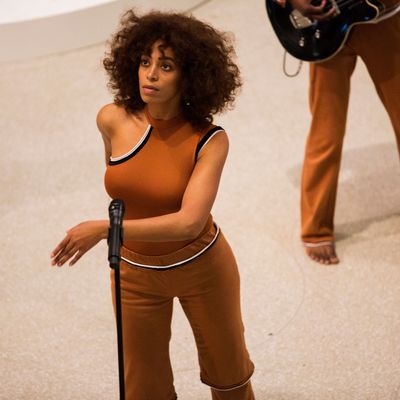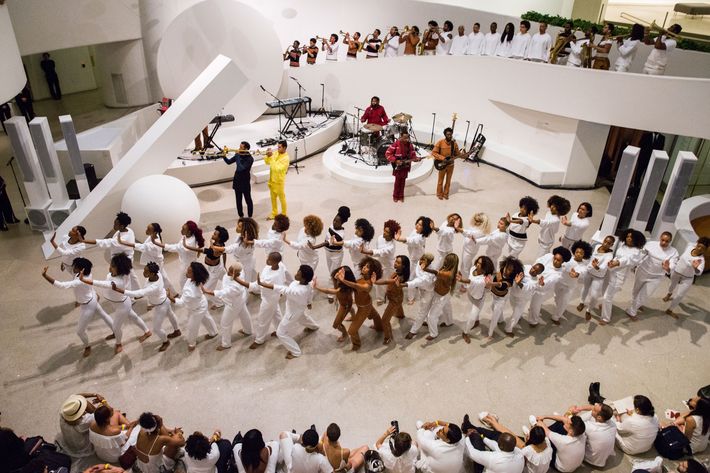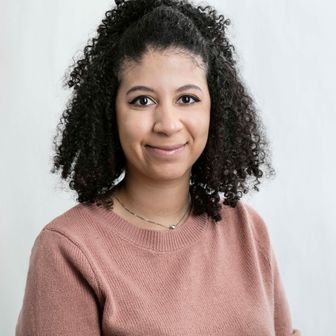
The Solomon R. Guggenheim Museum was built to be a cathedral home to the religion of late-19th and 20th-century art, but its reputation for being a house of worship for all its architectural wonders precedes it. To Solange Knowles, however, Frank Lloyd Wright’s vision stands today as an empty, blindingly white space that she intended to fill with colorful bodies. On Thursday, Solange presented a double showing of “An Ode To,” a performance-art piece she choreographed, directed, and composed as part of the Red Bull Music Academy Festival, at the center of the Guggenheim before an audience that she instructed to wear all-white, like the people who commissioned and designed this New York City cultural destination. Attendees were asked to surrender their phones to completely immerse themselves in her work. The Guggenheim, she explained after her masterpiece’s finale, was not her choice because of the building’s history. Though both a student and teacher of art, she paid little regard to the gatekeepers of art history who’ve afforded the Guggenheim such prestige. Instead, Solange viewed the place as an aesthetically functional building convenient for “tearing down the fucking walls.” She did not come to kneel at the institution’s altar.
Solange’s career has been one defined by acts of disruption, all of which have been leading to this moment at the Guggenheim. She has complained loudly and relentlessly about the virulent experience of taking up space in worlds black women are told they do not belong in. When Solange started telling the world she not only liked, but identified with the music coming out of the era that popularized songwriters like Dirty Projectors’ Dave Longstreth (with whom she still collaborates), she joked to Vulture then that “the white kids aren’t going to jack our style anymore! We’re taking it back!” The declaration took on a darker tone when it meant she now had to be the mediator between that world and her own. In 2013, Solange famously defended Brandy’s critically panned album Two Eleven, scolding the indie-rock blogs and writers who now paid Solange their attention for not doing their homework on Brandy the way they would be expected to for a white indie-rock band. Last year, the memory of how she was treated for speaking up resurfaced and she took specific aim at a New York Times writer whom she says told her at the time not to “bite the hand that feeds her.” “The music business was built brick-by-brick off the backs, shoulders, heart ache and pain, of black people, and everyone is just exhausted,” she tweeted. She again spoke publicly of feeling otherized when she tweeted her experience of coded racism at a Kraftwerk concert, where she was told to stop dancing and then physically berated when she refused.
The onus of mental exhaustion that comes from the constant wait for permission was the focal point of Solange’s greatest artistic achievement to date, 2016’s A Seat at the Table, just as it became the seed of an “An Ode To,” one of a select few performances Solange has opted to present in lieu of a traditional tour. (Yet another disruption.) At the show’s apex of brilliance, she took “Mad,” a song that dismantles the Angry Black Woman trope, from affirmation to direct order. She exercised her right to be mad with her band and backup singers — all of whom were barefoot and dressed in a palette of neutrals — letting out a scream after a revised chorus reclaiming that right to anger, then she let out another scream that lasted until the veins protruded from her neck. Then another, so loud and shrill it could’ve shattered the atrium’s glass ceiling.

When Vulture profiled the equally defiant artist Kara Walker, who just this week presented Solange with the Webby Award for Artist of the Year, she described the inevitable conflict that arises when a black woman inserts herself into places just like the Guggenheim. “What are they debating, really? My right to exist?” she wondered. “I created this space where I as the artist was also the Negress who is to some extent living in the master’s house or vying for the master’s attention.” Solange, in her closing speech, spoke of why “inclusion and allowance are not enough,” and how even her occupying this space — no matter the creative autonomy — is limited if she and those like her do not shake the ground of these cultural masters’ houses so that the walls begin to crumble. Solange’s strongest quake, then, wasn’t her yell during “Mad,” or her cover of Syreeta Wright’s quietly devastating “Black Maybe,” or even her performance of “Cranes in the Sky,” which saw her soaring final note reach an even higher octave that enveloped the atrium.
The seismic shift in both the show’s tempo — mostly meditative and accented by turns of stillness and sudden, sharp choreographed movements by Solange, her dancers, and her band — and what a black auteur like Solange could represent to these institutions happened during “F.U.B.U.”, a song she wrote specifically for the black culture in attendance. In a simple and final (for the night, anyway) act of rebellion, she sauntered over to the side of her all-white stage, turned her back to the crowd seated in front of her at her table, bent over, and started thrusting and gyrating her body into a glorious twerk. The bigger the bounce, the louder the crowd erupted. Solange carried this energy through to her show’s conclusion: a choreographed march of dozens of black female dancers, an all-black horn section that popped up from within the spiral staircase to play intermittently during the show, and, then, finally just Solange alone, jumping all over the Guggenheim floor — even getting right down on it — with movements that resembled muscle spasms of unbridled joy. Solange spoke with the force of her body and its ability to express elation where it was once struck down. It was an ode to her freedom.



